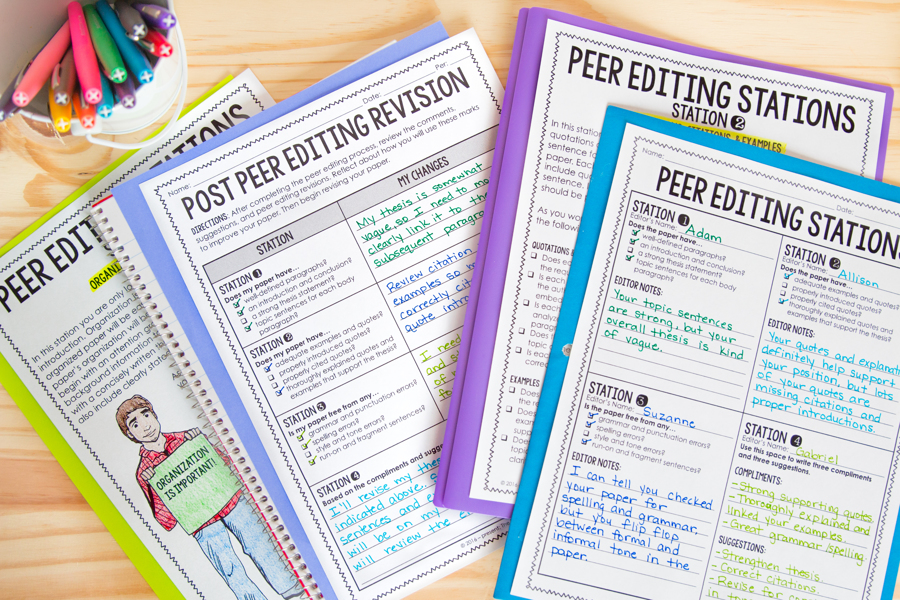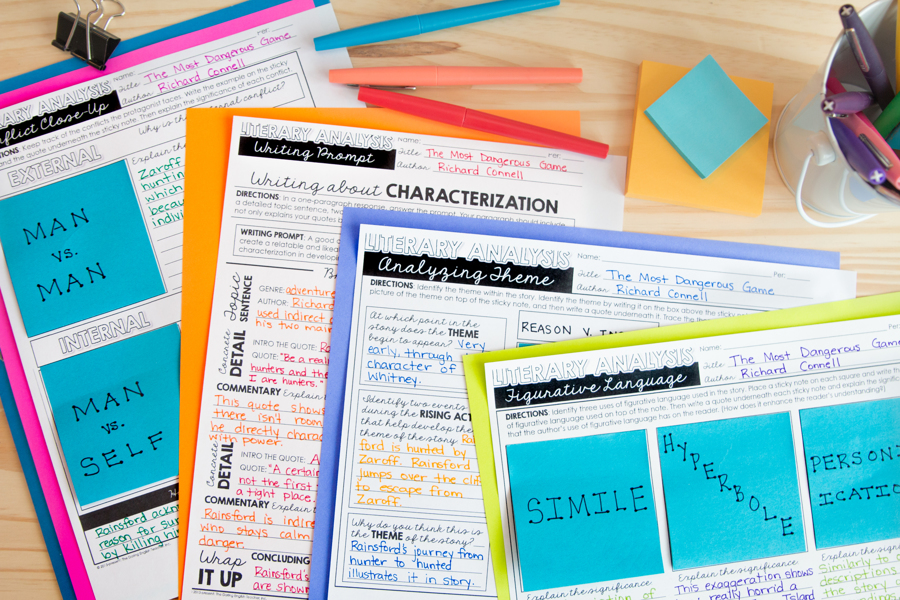Purposefully including group work in your classroom instruction has many benefits. From increased engagement to real-world communication skills, students can learn more than just the ELA content when they collaborate.
Here are six different ELA activities that work great as group activities.
1. Peer Review as a Group Activity
Completing a peer review activity in a group may seem like an obvious choice. Still, it is very effective for editing essays and helping students bring their writing to its full potential. One way to make peer editing even more beneficial is to put your students in groups of four and have them rotate their essays around the group until three different people have edited everyone’s writing. This process is what I do when my students complete my Peer Editing Stations and Rotations activity. Not only do students benefit from having multiple people read their paper, but they also get to read several other students’ papers.
Peer editing in groups is a great way to ensure that more than one opinion goes into the editing process. Different people may have different ways of editing, and it helps students evaluate what changes will work best in their specific piece of writing.
 |
| Peer Editing Stations |
Resources for Peer Review:
2. Passage Analysis as a Group Activity
Placing students into groups to analyze different passages is a great way to close-read multiple sections of text. An effective way to do this is to break up a chapter of a book into smaller sections and assign a few students to each section. In these groups, students will read their passage together and talk about the theme, tone, message, and the main idea of the section. After about 10-15 minutes, each group can share what they discussed about their specific passage. The class can take notes on what each group said, and at the end of the exercise, students will have a comprehensive analysis of the whole chapter.
This is a great assignment if you have a mixture of personalities in your classroom. The more reserved students will have a chance to share their ideas about a specific section with their group, not to be overwhelmed by a large class environment. This is also perfect for when you are focusing on close reading in your class. Doing a close reading in small groups is effective for introducing students to the kinds of things to take note of during an individual close reading assignment.
 |
| Literary Analysis with Sticky Notes |
Resources for Literary Analysis:
3. Group brainstorm in the Classroom
Most students will get writer’s block at some point in their English class, and a good case of writer’s block can quickly lead to classroom management issues when it is time for students to sit down and begin drafting their essays. One of the easiest ways to combat writer’s block while also helping struggling students is to conduct group brainstorming sessions before every major writing assignment.
Dedicating time for small group brainstorming will help students talk through ideas for what they might want to write about and get input from other students. Ask students to come up with a few topics they might want to write about for their next essay and bring them to class. Split your class into groups of four to five students and have each student share some of their ideas for the assignment. As they do so, students will also receive feedback from the rest of the group. This type of group activity works for both creative writing assignments and analytical assignments. In their groups, students will receive feedback from other students and help hone down their ideas. If a student is lost on what to write about, talking with a group might spark a new idea.
Looking for more group brainstorming ideas, check out this blog post!
4. Act Out a Scene from Literature
When reading a novel, it can help students act out specific scenes to help them fully understand what is happening. This helps the students acting and also the students observing. Split your class into small groups and assign each group a specific scene. Give them enough time to read through the scene and plan a short skit in front of the rest of the class. Each student could be a different character, or there could be a mix of characters and narrators, depending on the text. When reading through a section of a novel to plan out a skit, students may notice details that they missed during their first read through. This helps the group acting and the other groups that are watching. This activity works best with novels that have characters with enough dialogue to have a scene but enough description to read between the lines.
5. Defend your Favorite Character
This activity is great when reading a novel or a play with several different characters. Have students choose their favorite character from the text you are reading and split students into groups based on those characters. Each group will come up with reasons why that character is their favorite, and then the groups will have a chance to pitch their reasoning to the rest of the class. This activity is a fun way to expose students to thinking, speaking, and writing persuasively. By listening to various reasons why each group chose a specific character, students will broaden their perspective and recall details about characters they may not have noticed during their first read.
6. Collaborative Writing Assignments
I’ve blogged before about the benefits of collaborative writing assignments. Students learn so much when they spend the class period working together to produce a collaborative writing piece. Some of my favorite collaborative writing assignments are the class collaborative precis and a short story collaborative literary analysis paragraph.
All of these group activities have different benefits, and they are great for changing up the classroom environment and getting every student involved in the material. Hands-on group activities will help students enhance their reading and writing skills while adding some fun to the classroom.



